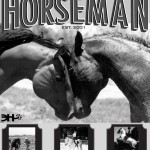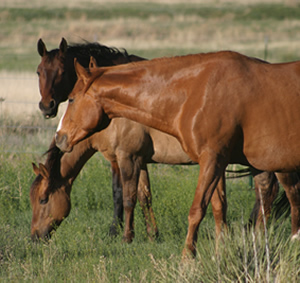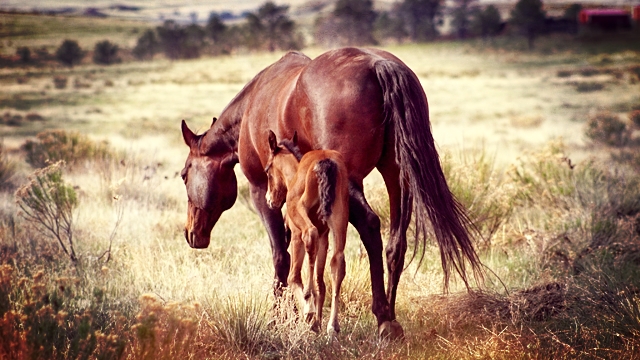Written by Sue Stuska, Ed.D.

Colic. The word strikes fear in the hearts of horsemen. And well it should. It is one of the leading causes of death in horses. However, there are ways to reduce your horse’s risk, and early recognition will help you work with your vet to increase your horse’s chance of recovery.
WHAT IS COLIC?
Colic is abdominal pain. That’s the straightforward part. The complicated part is that it can be due to a number of causes; some causes are predictable but often the cause is unknown.
Colic involves the digestive system below the esophagus. Colic pain can be due to gas distention, a partial or full blockage of the intestine, a damaged portion of the gut tube, or spasms of the digestive tract. It can include a twist, or a stricture when part of the intestine gets trapped over another section (the intestine is relatively loosely hung inside the abdomen so bulk can pass freely, but this also can cause problems). Serious cases can include rupture.
Colic may affect more than one horse at a time if they are all reacting to the same situation, but most often it will strike one horse. It can occur as a side reaction to a transmissible disease, or in addition to a serious condition such as founder; it’s not contagious.

PREVENTION
It’s impossible to absolutely prevent colic. Even the most carefully managed horse may colic that’s one of the scary things about the disease. Forces beyond our control like changes in the weather can contribute to colic. Parasite damage dating from before you got your horse can lead to colic even though you immediately began, and stick with, a top-notch deworming schedule.
However, there are a number of predictable precursors of colic that are within our control. Perhaps the reason they are not well recognized is that they don’t predictably cause colic you or a friend may have done something all along and never had any problems. However, as your powers of observation develop, you may recognize minor symptoms that you’d overlooked before. And, once you know some of the potential causes of colic, you may be able to prevent cases in your horse.
Make feed changes slowly. The horse’s digestive system becomes acclimated to whatever he’s eating. The digestive tract contains microbes that help break down specific materials. If the diet suddenly changes, the microbes aren’t prepared this can throw routine digestion off enough to cause colic. For the same reason, take steps to absolutely prevent accidental grain overdose. If you need to change grain mixes, or are about to run out of hay, resupply in time to make a gradual switch (1/4 new to 3/4 old, 1/2 and 1/2, etc.). The bigger the difference in feeds or amounts, the longer the switch should take.
Feed quality hay and grain. Avoid moldy feed which can cause digestive upset. Finely ground grains can cause blockage. Choose clean fresh hay, without weeds.
Provide grass, or feed hay in as many feedings as your schedule permits. The horse’s digestive system is geared to taking in small amounts over most of the day, rather than eating once or twice a day at feeding time.
Limit the sand and dirt the horse ingests by feeding him off the ground. Sand can collect in the intestine and cause irritation, twists, and blockages. Along with your good management, some horsemen in sandy areas feed commercial products designed to help the horse pass the sand he ingests.
Deworm regularly. A heavy load of parasites living in the digestive tract can cause painful irritation, partial, or full blockage. Immature forms of the worms migrating in the circulatory system can compromise the blood supply to a section of intestine; that section’s effectiveness will diminish and it may die.
Cool a hot horse fully after work and before a meal. When a horse has been working hard enough to be hot, his circulatory system is geared to supply blood to his muscles. He needs to cool down (blood coursing through surface vessels helps this process) and allow the circulatory system to re- orient to the digestive organs before digesting a meal.
Don’t allow a horse who’s been deprived of water access to an unlimited supply. Instead, offer a few swallows at a time alternated with walking (if he’s been on a trailer or working) and a few mouthfuls of green grass.
Provide clean, fresh, comfortable temperature water at all times (other than the above). A leading cause of colic is eating but not drinking enough to lubricate the feed; this often happens when the water is too cold in the winter. A brief cold snap can be enough to get your horse to avoid his water; warm the water and monitor his intake.
SOME COMMON MYTHS
Pelleted feed causes colic. Pelleted feed is, in fact, more easily digestible than less processed feeds. However, a horse who does not have access to water, or who does not drink enough because the water is too cold in the winter, may finally drink and cause the pellets to expand with the moisture. This can cause distention and colic pain.
Never water a hot horse. Hard working horses must replenish the moisture lost in sweat, and particularly if the horse is working for a long time (as in endurance, competitive trail rides or eventing) he must drink a great deal during the day to stay hydrated. Sweat, a key to cooling, is facilitated by enough internal moisture. The key is to avoid long periods of deprivation so that he is able to keep up his hydration by letting him sip along the way without the need to drink excessive quantities at any one time.
Watering a horse after he eats grain will wash the feed out of his stomach, thus preventing full digestion. The stomach is able to move liquids along while continuing to digest the concentrates. The horse should have access to water before, during and after eating.
Keep a colicing horse walking to keep him from rolling. Walking can be helpful; the gentle movement may help get the digestive system back to normal. However, hours of walking can exhaust both you and the horse. If, after a walk, he is content to stand quietly, let him.
Don’t allow a colicing horse to roll; he may twist his intestine. He may already have a twist, and that’s what’s causing the pain. Horses admitted to surgery who have never rolled can still have a section of bowel looped over another. Uneven loading of a portion of the intestine due to gas, blockage, or diseased gut tissue, may cause twists. Therapeutic rocking (done by the vet, if not by the horse himself) has been shown to correct some strictures.

SYMPTOMS
Recognizing colic is easy even though the horse can’t tell you in so many words that he’s hurting or where he hurts. A colicing horse shows one or more of these signs, in combinations depending on his situation. Just one symptom does not mean colic, but it merits watching.
These have a range of intensity. Be sure to note the intensity this gives you a clue to the level of pain. Also note whether symptoms come and go or are constant. Unfortunately, the symptoms don’t necessarily tell you how serious the colic is.
Off feed. A mildly colicing horse might eat a little, or he might be totally disinterested. This is probably for the best, because with impaction colic you don’t want any additional feed on top of the blockage. Remove any remaining feed.
Looking at his sides. Turning repeatedly to gaze at his abdomen is a common symptom of colic. Increased pain may elicit closed-mouth thumps to his belly. He may kick or swish his tail at his abdomen. Note if one side seems to be more painful than the other; this can be a clue for your vet.
A bloated or tucked-up look to the abdomen. Painful gas can cause a bloated look, while a dehydrated horse can look tucked-up.
Stretching. Stretching like a male horse about to urinate can indicate belly pain.
Constipation, or small amounts of manure passed at intervals. Depending on what part of the digestive system is affected, he may or may not pass feces. Note the presence or absence, and the consistency (dry, or loose). In general, passing normal feces in normal amounts is good news.
Decreased alertness. A horse in pain will appear to be focused on himself. He’ll be less interested in what’s going on around him. You’ll notice that he’s less likely to prick his ears or turn his head. His expressions will be distracted, and his attention will be toward what’s going on inside his body.
Lying down. A mildly colicing horse might lie down at an inappropriate time. We’re used to seeing pastured horses lie on sunny hillsides in the winter, and having our stabled horses lie down for a short time at night. But a horse lying down when he normally wouldn’t (when others are eating, when he’s tied for grooming, while trailering), or lying down where he normally wouldn’t (in a cold wet area), might be in pain.
Pawing. Pawing may accompany lying down, or it may alternate with other symptoms.
Lying down and getting back up. A horse that lies down, then gets up, only to lie down again, may be trying to find a comfortable position or ease the ache in his gut. He may lie sternally (sternum down, with legs tucked under him) or laterally (flat on his side), and may change positions.
Rolling. Rolling in a freshly bedded stall, or when turned out after a ride, are normal. A colicing horse rolls because of the pain. He is likely to roll more often; possibly repeatedly. He may roll violently. He may roll on his back like a dog or go down vertically onto his belly.
For both an up-and-down and a rolling horse, change his location if needed for safety. If he is in a small space, take him out to an open area where he’s less likely to get cast (to lie down so close to the wall that he can’t get up) or get a leg caught (under a fence, for example). Choose a soft surface with good purchase (grass, soft bedding, or an arena) so he’s more comfortable when he’s down, can get his footing easily to rise, and so he’s less likely to get abraded. Stay out of his way use a long lead if necessary because he may not be paying attention to you.
A lot of these symptoms are based on differences from normal. Notice what’s normal for your horse, and then recognize the deviations. An educated horseman detects symptoms early and starts to monitor the situation.
A lot of these symptoms are also found with other diseases. For example, a foundering horse’s feet hurt so he’s likely to stretch out, or to lie down more than normal. But he’s not going to look at his sides. A horse who’s choking (feed stuck in his esophagus) may not be interested in eating, but he’s likely to be working his neck muscles trying to swallow and will probably have chewed food and saliva coming from his nose.
Monitor the horse. Colic pain may stay relatively mild through the episode, can go away and reoccur, or can progress rapidly to include extreme pain. As soon as you realize your horse is colicing, call your vet. Describe the symptoms. If they are mild, the vet may ask you to continue to monitor them and call back in an hour with an update. Or, he or she may come right out. Be ready to pay an after-hours fee if it’s outside business hours (it’s worth it). The symptoms aren’t necessarily reliable in showing the situation inside the horse. In some cases, early intervention makes all the difference (and in other cases, there may have been, sadly, no hope from the beginning).
Thankfully, some cases of colic are mild and the digestive system is able to put itself right on its own.
SURGERY
Unfortunately, there’s not always clear symptoms that show which colic cases need surgical intervention (versus those that will respond to medical care). Substantial blockages, persistent twists, and ruptures may benefit from surgery, though surgery is not a sure cure. Your vet may feel surgery is indicated, and you’ll have the opportunity to make an informed decision if you take a little time now for research. How far away is the nearest colic surgery facility? If surgery is indicated, the distance (and therefore the time) to the nearest facility may make surgery an option or rule it out. Your horse’s condition to travel must be taken into account at the time. How will you get him there? If you don’t own a trailer, or he doesn’t load easily, plan ahead with a friend so you have suitable transportation available and get to work on training. How much money will you spend? Most of us will fight to save our friend at any cost, but it’s smart to check out the potential costs (in the thousands of dollars) for surgical intervention and the hospital stay. Colic surgery insurance (which helps pay the bills) may be available for a reasonable fee for your horse; check out some insurance companies for rates.
This article originally appeared in Eclectic Horseman Issue No.1


